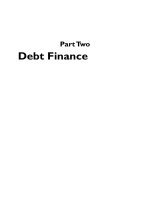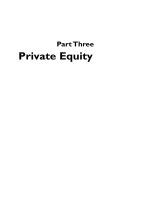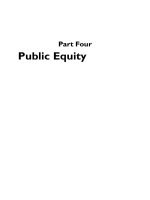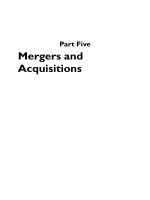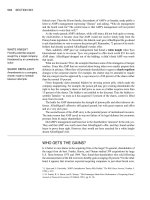Fundamentals of corporate finance brealey chapter 10 introduction to risk return and opportunity cost of capital
Bạn đang xem bản rút gọn của tài liệu. Xem và tải ngay bản đầy đủ của tài liệu tại đây (131.58 KB, 14 trang )
Solutions to Chapter 10
Introduction to Risk, Return, and the Opportunity Cost of Capital
1.
Return =
= = .15 = 15%
Dividend yield = dividend / initial price = 2/40 = .05 = 5%
Capital gains yield = capital gains / initial price
= 4/40 = .10 = 10%
2.
Dividend yield = 2/40 = .05 = 5%. The dividend yield is unaffected; it is based on the
initial price, not the final price.
Capital gain = $36 – $40 = −$4
Capital gains yield = –4/40 = –.10 = – 10%
3.
a.
Rate of return
=
=
Real rate = − 1 = − 1
b.
Rate of return
=0
= –.0291 = –2.91%
= = .05 = 5%
Real rate = − 1 = − 1 = .0194 = 1.94%
c.
Rate of return
= = .10 = 10%
Real rate = − 1 = − 1 = .0680 = 6.80%
10-1
Copyright © 2006 McGraw-Hill Ryerson Limited
4.
Real return = − 1
Costaguana: Real return = − 1 = .0833 = 8.33%
Canada: Real return = − 1 = .1067 = 10.67%
Canada provides the higher real return despite the lower nominal return. Notice that
the approximation
real rate ≈ nominal rate – inflation rate
would incorrectly suggest that the Costaguanan real rate was higher than the Canadian
real rate. The approximation is valid only for low rates.
5.
We use the relationship (with all rates expressed as decimals) that:
Real rate = − 1
Asset class
Treasury bills
Gov’t bonds
Common stocks
6.
Nominal Return
4.7%
6.5
11.7
Inflation
3.2%
3.2
3.2
Real Rate
1.45%
3.20
8.24
The nominal interest rate cannot be negative. If it were, investors would choose to
hold cash (which pays a return of zero) rather than buy a bill providing a negative
return. On the other hand, the real expected rate of return is negative if the inflation
rate exceeds the nominal return.
7.
Average price of
Quarter stocks in market
1
902.50
2
866.67
Index (using
DJIA method)
100.00
96.03
10-2
Copyright © 2006 McGraw-Hill Ryerson Limited
Total market
value of stocks
628,880
608,260
Index (using
S&P method)
100.00
96.72
3
4
888.33
876.67
98.43
97.14
607,760
569,100
96.64
90.49
8.
Quarter
Sep.
2003
Dec.
2003
Mar.
2004
Average
rate of
return
Standard
deviation
of return
Tanzania
Brewerie
s,
Quarterly Rates of Return
Tanzani
a
Equal weighted
Cigarett
Tanzania
e
portfolio
Tea
Compan
Dahac
Packers
y
Simba
o
1/6 of each stock
TOL
-0.0317
0
-0.1667
-0.0164 -0.019
0.04
-0.0397
0.16
0.0118 0.0145 0.0962
0.025
0
-0.0172
0 0.1857 0.0175
-0.0131
-0.0605 -0.006
-0.008
0.0635 0.0109
0.1635
-0.1333
-0.0423 -0.0143
-0.0102
0.062 0.0512
-0.0093
0.0284 0.1081 0.0405
0.0325
The simple average of the individual stocks’ standard deviation, is .0692 or 6.92%.
The standard deviation of the equal-weighted portfolio, shown in the table, is
3.25%. This is striking evidence of the benefits of diversification.
Note: Since the question works with observed data, the sample standard deviations
are calculated. Thus for each stock the average rate of return is calculated. Then, for
each quarter, the squared difference between the quarter’s’s return and the average
rate of return for all quarters is calculated. The squared deviations are summed and
divided by 2 (the number of quarterly returns s minus 1). This gives the sample
variance. The sample standard deviation is the square root of the sample variance.
9.
2003
2004
2005
2006
2007
average
Std. Dev.
TSX
26.61
14.58
24.39
17.01
9.83
18.48
6.95
T-Bill
Long Bond
2.93
8.06
2.24
8.46
2.65
15.05
4.01
3.22
4.28
3.30
3.22
7.62
0.88
4.85
10-3
Copyright © 2006 McGraw-Hill Ryerson Limited
TSX risk
Long bond risk
premium
premium
23.68
5.13
12.34
6.22
21.74
12.40
13.00
-0.79
5.55
-0.98
15.26
4.40
7.43
5.56
b.
The average TSX risk premium was 15.26 %. The average long bond risk
premium was 4.4% for these five years. These results are largely due to the
very good performance of the TSX in 2003 to 2007.
c.
A fast way to calculate standard deviation of a sample of data is using a
spreadsheet, such as Excel. In Excel, use the STDEV function. Alternatively,
the standard deviation can be calculated by hand. First, calculate the sample
variance, then take the square root. The sample variance is the sum of the
squared deviations from the mean, divided by the number of observations
minus 1. We illustrate with the TSX risk premium:
Variance of TSX risk premium
= [1/(5-1)] × [(23.68 – 15.26)2 + (12.34 – 15.26)2 + (21.74 – 15.26)2
+ (13.0 – 15.26)2 + (5.55 – 15.26)2
= 55.20
Standard deviation of TSX risk premium = = 7.43%
We would expect that the risk premium standard deviation would be higher
for the TSX than for the Long Bond portfolio. This is what we find: the TSX
risk premium has a 7.43% standard deviation and the Long Bond risk
premium has a 5.56% standard deviation. There is more variation in the
TSX risk premium because there is more variation in the TSX return than for
the Long Bond portfolio.
10.
In 2007, the S&P/TSX was more than four times its 1990 level. Therefore a 40point movement was far less significant in percentage terms than in 1990. We
would expect to see more 40-point days even if market risk as measured by
percentage returns is no higher than in 1990.
11.
Investors would not have invested in bonds if they had expected to earn negative
average returns. Unanticipated events must have led to these results. For example,
inflation and nominal interest rates during this period rose to levels not seen for
decades. These increases, which resulted in large capital losses on long-term bonds,
were almost surely unanticipated by investors who bought those bonds in prior
years.
The results from this period demonstrate the perils of attempting to measure “normal”
maturity (or risk) premiums from historical data. While experience over long periods
may be a reasonable guide to normal premiums, the realized premium over short
periods may contain little information about expectations of future premiums.
12.
If investors become less willing to bear investment risk, they will require a higher
risk premium for holding risky assets. Security prices will fall until the expected
rates of return on those securities rise to the now-higher required rates of return.
10-4
Copyright © 2006 McGraw-Hill Ryerson Limited
13.
Based on the historical risk premium of the TSX (7.0 percent), and the current level
of the risk-free rate (about 2.75 percent), one would predict an expected rate of
return of 9.75 percent. If the stock has the same systematic risk, it also should
provide this expected return. Therefore, the stock price equals the present value of
cash flows for a one-year horizon.
2 + 50
P0 = 1.0975 = $47.38
14.
Boom
= 122.22%
Normal
= 13.33%
Recession
= –100%
Expected return = .3 × 122.22 + .5 × 13.33 + .2 × (−100)= 23.33%
Variance = 0.3 × (122.22 − 23.33)2 + .5 × (13.33−23.33)2 + .2 × (−100−23.33)2 = 6025.8
Standard deviation = = 77.63%
15.
The bankruptcy lawyer does well when the rest of the economy is floundering, but
does poorly when the rest of the economy is flourishing and the number of
bankruptcies is down. Therefore, the Tower of Pita is a good hedge. When the
economy does well and the lawyer’s bankruptcy business suffers, the stock return is
excellent, thereby stabilizing total income. The owner of the gambling casino
probably does well when the economy is flourishing and less well when it is doing
poorly. For the casino owner, holding Tower of Pita stock will not stabilize total
income as much as it does for the bankruptcy lawyer.
16.
Rate of Return
Boom
= –28%
Normal
=
Recession
= 48%
8%
Expected return = .3 × (−28%) + .5 × 8% + .2 × 48% = 5.2%
10-5
Copyright © 2006 McGraw-Hill Ryerson Limited
Variance = .3 × (−28 – 5.2)2 + .5 × (8 – 5.2)2 + .2 × (48 – 5.2)2 = 700.96
Standard deviation = = 26.5%
Portfolio Rate of Return
Boom
Normal
Recession
(−28 + 122.22)/2 = 47.11%
(8 + 13.33)/2 = 10.665%
(48 –100)/2 = –26.0%
Expected return = .3 × 47.11% + .5 × 10.665% + .2 × (-26.0%) = 14.27%
Variance = .3 × (47.11 – 14.27)2 + .5 × (10.665 – 14.27)2 + .2 × (-26.0 – 14.27)2
= 654.4
Standard deviation = = 25.6%
Standard deviation is lower than for either firm individually because the variations
in the returns of the two firms serve to offset each other. When one firm does
poorly, the other does well, which reduces the risk of the combination of the two.
17.
a.
Interest rates tend to fall at the outset of a recession and rise during boom
periods. Because bond prices move inversely with interest rates, bonds will
provide higher returns during recessions when interest rates fall.
b.
rstock = .2 × (−5%) + .6 × 15% + .2 × 25% = 13%
rbonds = .2 × 14% + .6 × 8% + .2 × 4% = 8.4%
Variance(stocks) = .2 × (−5−13)2 + .6 × (15−13)2 + .2 × (25 – 13)2 = 96
Standard deviation = = 9.80%
Variance(bonds) = .2 × (14−8.4)2 + .6 × (8−8.4)2 + .2 × (4−8.4)2 = 10.24
Standard deviation = = 3.20%
18.
c.
Stocks have higher expected return and higher volatility. More risk averse
investors will choose bonds, while others will choose stocks.
a.
Recession
Normal
Boom
(−5% × .6) + (14% × .4) = 2.6%
(15% × .6) + ( 8% × .4) = 12.2%
(25% × .6) + ( 4% × .4) = 16.6%
10-6
Copyright © 2006 McGraw-Hill Ryerson Limited
b.
Expected return = .2 × 2.6% + .6 × 12.2% + .2 × 16.6% = 11.16%
Variance = .2 × (2.6 – 11.16)2 + .6 × (12.2 – 11.16)2 + .2 × (16.6 – 11.16)2
= 21.22
Standard deviation =
c.
21.22 = 4.61%
The investment opportunities have these characteristics:
Stocks
Bonds
Portfolio
Mean Return
13.0%
8.4
11.16
Standard Deviation
9.80%
3.20
4.61
The best choice depends on the degree of your aversion to risk. Nevertheless,
we suspect most people would choose the portfolio over stocks since it gives
almost the same return with much lower volatility. This is the advantage of
diversification.
d.
To calculate the correlation coefficient, rearrange the formula for the portfolio
standard deviation as we did in Check Point 10.7.
Correlation between bond and stock returns
= (σp2 – xs2 σs2 – xb2 σb2) / ( 2 xs xb σs σb)
= (.04612 – .62× .0982 – .42 × .0322) / ( 2 × .6 × .4 × .098 × .032) = -.995
The stocks and bonds are almost perfectly negatively correlated.
19.
If we use historical averages to compute the “normal” risk premium, then our
estimate of “normal” returns and “normal” risk premiums will fall when we include
a year with a negative market return. This makes sense if we believe that each
additional year of data reveals new information about the “normal” behaviour of the
market portfolio. We should update our beliefs as additional observations about the
market become available.
20.
Risk reduction is most pronounced when the stock returns vary against each other.
When one firm does poorly, the other will tend to do well, thereby stabilizing the
return of the overall portfolio. By contrast stock returns that move together provide
no risk reduction. If stock returns are independent, some risk reduction (variability
reduction) occurs but it is less than if the stock returns vary against each other.
10-7
Copyright © 2006 McGraw-Hill Ryerson Limited
21.
22.
23.
a.
General Steel ought to have more sensitivity to broad market movements.
Steel production is more sensitive to changes in the economy than is food
consumption.
b.
Exotic World Tours Agency sells a luxury good (expensive vacations) while
General Cinema sells movies, which are less sensitive to changes in the
economy. Exotic World Tours Agency will have greater market risk.
a.
Expected return = .5 × (-20%) + .5 × 30% = 5%
Standard deviation = [ .5 × (-20% - 5%)2 + .5 × (30% - .5%)2]1/2 = 25%
The expected rate of return on the stock is 5 percent. The standard deviation
is 25 percent.
b.
Because the stock offers a risk premium of zero (its expected return is the
same as for Treasury bills), it must have no market risk. All the risk must be
diversifiable, and therefore of no concern to investors.
Sassafras is not a risky investment to a diversified investor. Its return is better when
the economy enters a recession. Therefore, the company risk offsets the risk of the
rest of the portfolio. It is a portfolio stabilizer despite the fact that there is a 90
percent chance of loss.
(Compare Sassafras to purchasing an insurance policy. Most of the time, you will
lose money on your insurance policy. But the policy will pay off big if you suffer
losses elsewhere — for example, if your house burns down. For this reason, we
view insurance as a risk-reducing hedge, not as speculation. Similarly, Sassafras
may be viewed as analogous to an insurance policy on the rest of your portfolio
since it tends to yield higher returns when the rest of the economy is faring poorly.)
In contrast, the Leaning Tower of Pita has returns that are positively correlated with
the rest of the economy. It does best in a boom and goes out of business in a
recession. For this reason, Leaning Tower would be a risky investment to a
diversified investor since it increases exposure to the macroeconomic or market risk
to which the investor is already exposed.
24.
a.
Portfolio expected return = .3 × 9% + .7 × 8% = 8.3%
Portfolio standard deviation = [.32 × .22 +.72 × .252 + 2 × .3 × .7 × .2 × .2 × .25]1/2
= .196 = 19.6%
b.
With correlation of .7, the portfolio standard deviation is
= [.32 × .22 +.72 × .252 + 2 × .3 × .7 × .7 × .2 × .25]1/2
= .221 = 22.1%
10-8
Copyright © 2006 McGraw-Hill Ryerson Limited
c.
25.
The higher is the correlation between two variables, the less potential for
diversification. In (a), with correlation of only .2, the portfolio standard
deviation is less than the standard deviation of return of either of the two
stocks in the portfolio. However, with the higher correlation of .7, the stocks’
return move more closely together and forming a portfolio only somewhat
reduces total variability.
a.
The following table contains the annual rates of return, the five-year average rate of
return and the standard deviation of the rates of return for each index and the portfolio
with one-third in each of the indexes:
2003
2004
2005
2006
2007
average
Std. Dev.
TSX
26.61
14.58
24.39
17.01
9.83
T-Bill
Long Bond Portfolio
2.93
8.06
12.53
2.24
8.46
8.43
2.65
15.05
14.03
4.01
3.22
8.08
4.28
3.30
5.80
18.48
6.95
3.22
0.88
7.62
4.85
9.77
3.40
b. The table summarizes the calculations from (a):
Average
Standard
return (%) deviation (%)
TSX 300
18.48
6.95
Long Bond
7.62
4.85
Treasury Bill
3.22
0.88
Portfolio
9.77
3.40
The average standard deviation of the three securities is 4.23% = (6.95+4.85+0.88)/3,
higher than the portfolio standard deviation of 3.40%, showing the benefit of
diversification. If there were no benefits from diversification, the portfolio standard
deviation would simply be the average of the standard deviations of each of the
securities in the portfolio, weighted by their portfolio weights (here the weights are each
1/3).
26.
The correlation coefficients between the 3 quarterly rates of return on Tanzania
Breweries and each of the stocks are as follows:
Tanzania
Breweries
TOL
Tanzania
Tea
Packers
10-9
Copyright © 2006 McGraw-Hill Ryerson Limited
Tanzania
Cigarette
Company Simba
Dahaco
Correlation with TB
1.0000
(0.6009)
0.1694
(0.1927) (0.9678)
0.7990
As expected, the correlation of Tanzania Breweries with itself is 1. The stock offering
the best diversification benefit is Simba. Its return is most negatively correlated with
Tanzania Breweries’ rate of return.
27.
Internet:
Arithmetic Average
1928-2007
1967-2007
1997-2007
Risk Premium
1928-2007
1967-2007
1997-2007
Stocks
11.69%
11.98%
9.39%
T.Bills
3.91%
6.05%
4.13%
T.Bonds
5.26%
7.66%
6.71%
Stocks - T.Bills Stocks - T.Bonds
7.78%
6.42%
5.94%
4.33%
5.26%
2.68%
a. From the above tables, the overall risk premium is bigger when using the Treasury
Bill as the risk free security than using Treasury Bonds as the risk free security. This
makes sense: Treasury Bills are less risky than Treasury Bonds, making the difference
in risk between Treasury Bills and the market index bigger than the difference in risk
between Treasury Bonds and the market index.
b. The risk premium becomes smaller over time.
28.
Internet:
TD Canadian Index Fund,
/>style=na_eq&id=18353&gf_uid=globeandmail.gf.03428539934
3yr risk: 15.17
TD Precious Metals
/>style=na_eq&id=18350&gf_uid=globeandmail.gf.03428539934
3yr risk: 31.66
TD Energy
/>style=na_eq&id=18345&gf_uid=globeandmail.gf.03428539934
3yr risk: 25.16
10-10
Copyright © 2006 McGraw-Hill Ryerson Limited
TD Entert. & Communications GIF II
/>style=globe_eq&id=52905&gf_uid=globeandmail.gf.03428539934
3yr risk: 17.89
TD Health Sciences
/>style=na_eq&id=25995&gf_uid=globeandmail.gf.03428539934
3 yr risk: 11.17
Except for TD Health Sciences, the other sectors all have higher risk than the index
fund. It indicates some sectors have risk above Index, some below Index.
29.
Standard & Poor's
Expected results: Students have experience calculating rates of return for companies.
They will see differences in dividend and capital gains yields. One thing to note: The
S&P database provides a rolling 5 years worth of stock prices. At the time this data
was retrieved, there were not 5 December closing prices. If another month had been
selected, five years of data would have been available.
December
Closing Price
82.55
71.98
80.55
80.43
Dividend
1.15
1.52
1.52
1.48
2004
2005
2006
2007
14.64
7.72
7.51
6.73
Microsoft 2004
(MSFT) 2005
2006
2007
26.72
26.15
29.86
35.6
Company Year
Magna 2004
(MGA) 2005
2006
2007
Ford
(F)
Dividend
Yield
Capital Gains
Yield
Rate of
return
0.0184
0.0211
0.0184
-0.1280
0.1191
-0.0015
-0.1096
0.1402
0.0169
0
0.25
0.4
0.4
0.0171
0.0518
0.0533
-0.4727
-0.0272
-0.1039
-0.4556
0.0246
-0.0506
0.43
0.39
0.34
3.32
0.0146
0.0130
0.1112
-0.0213
0.1419
0.1922
-0.0067
0.1549
0.3034
10-11
Copyright © 2006 McGraw-Hill Ryerson Limited
30.
Expected results: Students will see diversification in action.
Return
GOOG
Return
BAC
Return
Portfolio
Return
22.330
(0.163)
359.36
0
(0.103)
24.170
(0.309)
(0.299)
0.166
26.690
(0.022)
400.52
0
(0.135)
35.00
0
4.460
(0.071)
27.290
0.061
463.29
0
(0.022)
31.140
(0.002)
4.800
(0.002)
25.720
(0.065)
473.75
0
(0.100)
32.90
0
0.378
59.240
(0.173)
4.810
(0.293)
27.510
(0.029)
526.42
0
(0.101)
23.87
0
(0.298)
(0.179)
May08
71.600
(0.041)
6.800
(0.177)
28.320
(0.007)
585.80
0
0.020
34.01
0
(0.094)
(0.060)
Apr08
74.630
8.260
0.444
28.520
0.005
574.29
0
0.304
37.54
0
(0.010)
0.155
Mar08
72.150
(0.014)
5.720
(0.124)
28.380
0.043
440.47
0
(0.065)
37.910
(0.046)
(0.041)
Feb08
73.210
(0.071)
6.530
(0.017)
27.200
(0.166)
471.180
(0.165)
39.74
0
(0.100)
(0.104)
Jan08
78.800
(0.020)
6.640
(0.013)
32.600
(0.084)
564.30
0
(0.184)
44.150
0.070
(0.046)
Dec07
80.430
(0.046)
6.730
(0.104)
35.600
0.060
691.48
0
(0.002)
41.26
0
(0.106)
(0.040)
Nov07
84.270
(0.111)
7.510
(0.153)
33.600
(0.087)
693.00
0
(0.020)
46.13
0
(0.045)
(0.083)
Oct07
94.760
(0.016)
8.870
0.045
36.810
0.249
707.00
0
0.246
48.28
0
(0.040)
0.097
Sep07
96.310
0.077
8.490
0.087
29.460
0.025
567.27
0
0.101
50.27
0
(0.008)
0.056
Aug07
89.450
0.020
7.810
(0.082)
28.730
(0.009)
515.250
0.010
50.68
0
0.069
0.002
Jul07
87.710
8.510
(0.097)
28.990
(0.016)
510.00
0
(0.024)
47.42
0
(0.030)
(0.041)
Jun07
90.990
9.420
0.129
29.470
(0.040)
522.70
0
0.050
48.89
0
(0.036)
0.025
MGA
Return
F
Return
Oct08
33.670
(0.342)
2.190
(0.579)
Sep08
51.190
(0.106)
5.200
Aug08
57.270
(0.031)
Jul08
59.100
Jun08
0.034
(0.036)
0.021
MSFT
10-12
Copyright © 2006 McGraw-Hill Ryerson Limited
0.124
(0.053)
0.005
(0.023)
0.042
May07
89.150
0.126
8.340
0.037
30.690
0.025
497.90
9
0.056
50.71
0
(0.004)
0.048
Apr07
79.150
0.054
8.040
0.019
29.940
0.074
471.380
0.029
50.90
0
(0.002)
0.035
Mar07
75.110
0.021
7.890
(0.003)
27.870
(0.011)
458.16
0
0.019
51.02
0
0.004
0.006
Feb07
73.570
(0.058)
7.910
(0.027)
28.170
(0.087)
449.45
0
(0.104)
50.83
0
(0.033)
(0.062)
Jan07
78.120
(0.030)
8.130
0.083
30.860
0.033
501.50
0
0.089
52.58
0
(0.015)
0.032
Dec06
80.550
0.048
7.510
(0.076)
29.860
0.017
460.48
0
(0.050)
53.39
0
(0.009)
(0.014)
Nov06
76.860
0.028
8.130
(0.018)
29.360
0.023
484.810
0.018
53.85
0
(0.000)
0.010
Oct06
74.800
Return
Portfolio
Return
8.280
MGA
Return
mean
(0.028)
stdev
0.093
F
476.39
0
28.710
Return
MSFT
(0.034)
0.182
Return
GOOG
53.87
0
Return
BAC
(0.007)
(0.006)
(0.025)
(0.020)
0.084
0.116
0.129
0.091
Mean standard deviation of the standard deviations of all five stocks: 0.121
- calculated as average of the individual stocks’ standard deviations
Portfolio standard deviation: 0.091
- calculated using the monthly rates of return of the portfolio
Notice that the portfolio has lower monthly standard deviation than the simple average
of the individual stocks’ standard deviations. This is due to the fact that the stock
returns are less than perfectly correlated. Diversification reduces portfolio standard
deviation.
31.
a.
b.
See solution of problem 30.
Correlation
MGA
F
MSFT
GOOG
BAC
MGA
1.000
0.692
0.483
0.441
0.550
F
0.692
1.000
0.326
0.529
0.551
10-13
Copyright © 2006 McGraw-Hill Ryerson Limited
c.
MSFT
0.483
0.326
1.000
0.657
0.098
GOOG
0.441
0.529
0.657
1.000
(0.001)
BAC
0.550
0.551
0.098
(0.001)
1.000
MGA and F, MSFT and GOOG are pairs of closely related industries, more
correlated than other pairs.
MGA: Magna International – makes car parts
F: Ford Motor Company – designs and assembles cars
MSFT: Microsoft – makes computer software
GOOG: Goggle – runs internet search business
BAC: Bank of America
10-14
Copyright © 2006 McGraw-Hill Ryerson Limited

